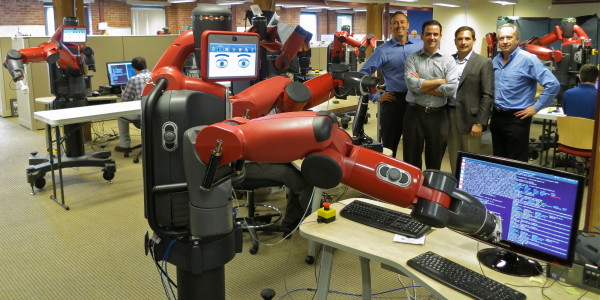We know the advantages of automation are terrific. Industrial robots work faster than humans, for longer periods of time, and with more precision. If we can automate the task, robots are generally cheaper and more efficient than people are at that task. We also know that with the advantages of industrial robots come potential safety risks. It’s difficult to make a massive metal arm that swings with incredible speed and force completely safe, after all. Still, we’ve taken measures to improve safety around industrial robots, and continue to ensure worker safety.
Now, there’s a new breed of robot on the factory floor. Collaborative robots are safe enough to deploy directly alongside human workers. But safer robots do not mean that we can now ignore safety. Here are some things to think about with collaborative robot safety.
Are collaborative robots safe now?
The safety barriers and buffers are gone in some factories. Humans can safely interact with machines to maximize productivity on tasks that are too difficult to automate, but can still benefit from mechanized enhancement. People and robots both bring strengths to manufacturing, and collaborative robots help bridge the gap between the performance of machines and the flexibility of human workers.
Current collaborative robots are safe enough to interact with human workers on plant floors. State of the art sensors, real-time responsiveness, and precision motion control have made collaborative robots possible. At the moment, these safety measures focus on preventing machine-human collisions. Motion, proximity, and even pressure sensors keep robots from hitting or harming workers, but is this really the only thing to consider with collaborative robot safety?
Even though collaborative robots are relatively safe, there’s still the potential for them to cause harm. If workers aren’t properly trained, a robot malfunctions, or incorrect settings are used, it’s conceivable that a collaborative robot could cause harm. However, this is also true of a saw, hammer, or any other type of tool. If workers use collaborative robots correctly, they’re safe.
Do they need to be safer?
Collaborative robots are defined as machines that can safely interact with human workers. Right now, collaborative robots look like Baxter – a robot that a worker would have to severely misuse to cause bodily harm. However, as we try and push the capabilities of collaborative robots, this could change.
Whenever there’s potential for improvement, people will try to make improvements. Yes, collaborative robots are safe, but they could be faster, or better at lifting things, or they could be more mobile. If we try and make this breed of robot more like its bigger, dangerous industrial cousin, we would make them less safe.
Trying to improve collaborative robot safety is as worthwhile a goal as making them faster or stronger. For example we could focus on developing collaborative robots that actively try to avoid contact with workers rather than just stop before hitting a human.
It’s clear that collaborative robots can improve the manufacturing process. It’s important, however, to identify the ways in which collaborative robots could cause harm, and prevent that from happening.
